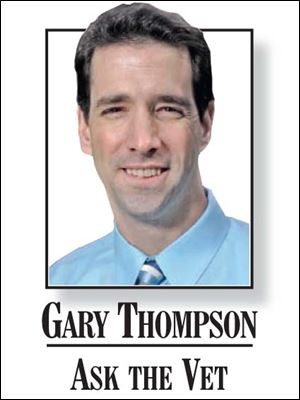
Deciding what, how much to feed pet is tricky
9/21/2013
Hands down, the most common question that the veterinarians in my practice receive is how much and what to feed a pet. Unfortunately, that is an incredibly complex question and pet food labeling requirements do little to help inform pet owners.
The most important aspect of how much to feed centers on whether or not your pet is overweight. For dogs, you should be able to feel the rib cage with gentle pressure right behind the shoulder blades.
Cats are a little trickier. They should have a noticeable waist behind the rib cage and a minimal belly underneath. As cats age they can carry some pretty hefty baggage in the undercarriage, so look closely. If they are overweight, estimating calorie intake can be difficult since the bags only give you a rough estimate of what to feed.
You also need to calculate the extra treats and snacks throughout the day. The biggest mistake is to read the bag and give three cups according to the weight, then add eight biscuits and wonder why the pet is overweight. The feeding guidelines are based on the food being the only calories your dog or cat gets throughout the day.
Another complicating factor is that one cup of one brand of dog food may have significantly more calories than another and consumers have no way to know the calorie content of the food. People will switch foods, even within the same brand, and assume they should keep feeding the same amount, which may be far too much or little.
The other part of the question is what to feed. That’s where things get especially tricky. Often people try to interpret the contents of a food and make a decision. Ingredients in food are listed according to weight, which includes moisture content.
You may see an advertisement that says chicken is the number one ingredient, but it is important to remember that might include moisture. On a dry matter basis corn meal may predominate, but they can list chicken since the pre-production weight would include the moisture in the chicken. The food also will only list guaranteed maximums and minimums of the fat, protein, moisture, and fiber. This has little bearing on the nutritional quality of the food and the amounts are dramatically different between dry and canned foods.
This also becomes important when pets have medical concerns that require limited ingredient diets. You may think you are feeding a lamb and rice diet, but from a labeling standpoint the contents only need to be 95 percent of the listed ingredients in order to warrant being called a lamb and rice diet. The other 5 percent can be any number of items that could be a problem.
This is not to say there are not good quality foods for your pets available commercially. Your veterinarian can recommend any number of diets that will be a good lifelong choice. If your pet has a medical condition that warrants a special diet, please be sure to check before making any changes, because when it comes to pet food labeling, what you see isn’t always what you get.
Questions for Dr. Gary Thompson can be emailed to askthevet@theblade.com or mailed to The Blade, Attn. Ask the Vet, 541 N. Superior St., Toledo, OH 43660. Dr. Thompson regrets that he cannot answer individual letters.